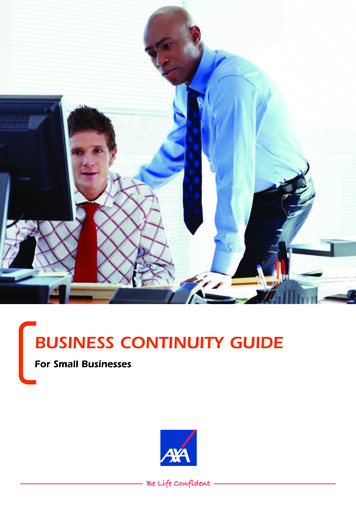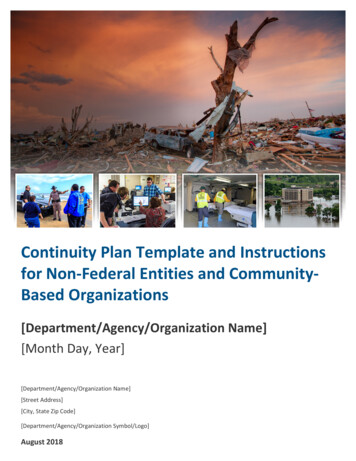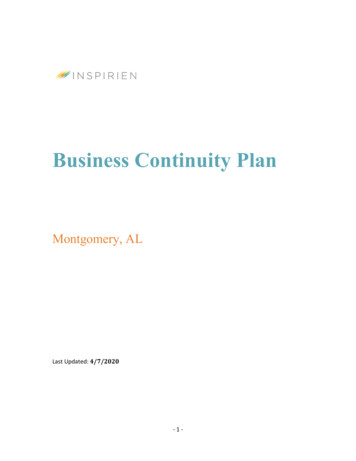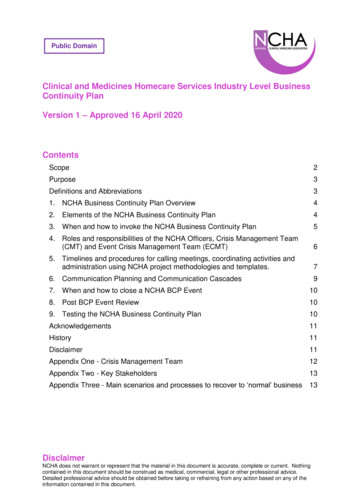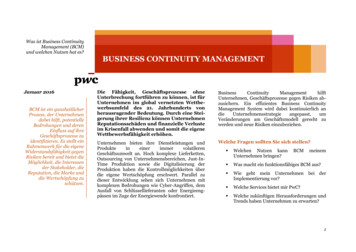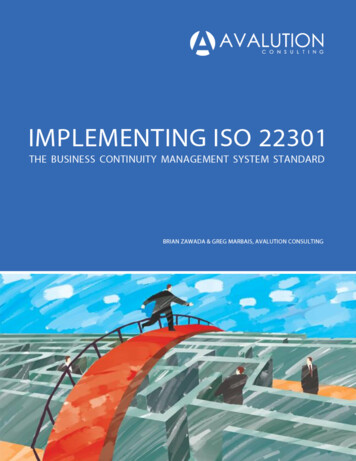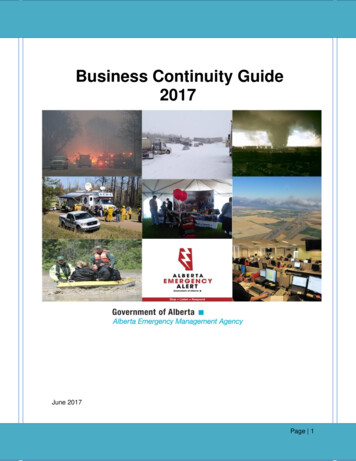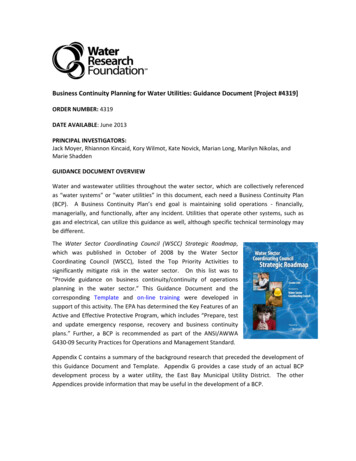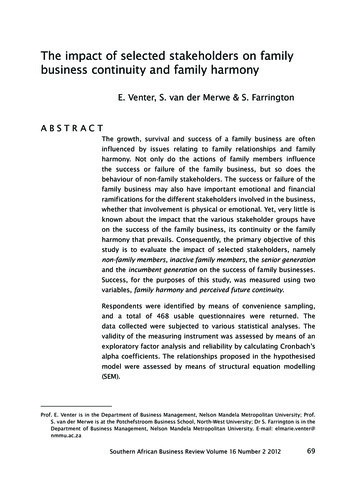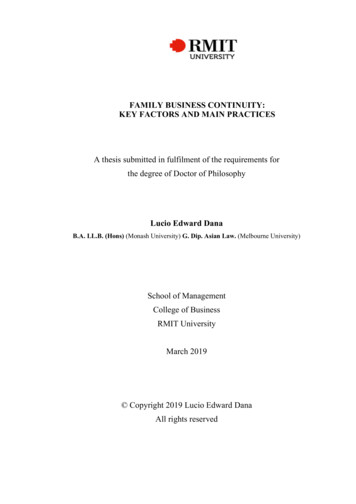
Transcription
FAMILY BUSINESS CONTINUITY:KEY FACTORS AND MAIN PRACTICESA thesis submitted in fulfilment of the requirements forthe degree of Doctor of PhilosophyLucio Edward DanaB.A. LL.B. (Hons) (Monash University) G. Dip. Asian Law. (Melbourne University)School of ManagementCollege of BusinessRMIT UniversityMarch 2019 Copyright 2019 Lucio Edward DanaAll rights reserved
Statement of AuthorshipI certify that, except where due acknowledgement has been made, the work is that of theauthor alone; the work has not been submitted previously, in whole or in part, to qualify forany other academic award; the content of the thesis is the result of work that has been carriedout since the official commencement date of the approved research program; and any editorialwork, paid or unpaid, carried out by a third party is acknowledged; and ethics procedure andguidelines have been followed.Lucio Edward DanaMarch 2019Declaration StatementI acknowledge the support I have received for my research through the provision of anAustralian Government Research Training Program scholarshipLucio Edward DanaMarch 2019ii
AcknowledgementsI wish to express my sincere appreciation to all persons who inspired, counselled, and assistedme during the course of this research program. Special thanks are due to:My supervisor, Professor Kosmas Smyrnios, for his understanding, incredible patience,constant encouragement, ongoing support, and personal guidance during my long candidature.Neither the initiation, nor the completion, of this thesis would have been possible without hisinspiration, feedback, and direction It took me a long time, but thanks to you Professor, Ifinally got there, and I am very grateful!My wife Prue, for her love, patience, and unwavering support over the eleven years of thisresearch project, as well as for her assistance with her diligent reviews first of the statisticsobtained from the National Family Business Survey undertaken in 2010 as part of thisresearch project, and second with the final versions of the draft thesis. My daughter Louisefor her valiant attempts to convert the older Word version of the draft thesis into a PDFdocument to preserve formatting by using her more recent Word software on her computer.Lin Xiong, Rui Bi, and Carmen Chu for their assistance with the structural equationmodelling work involved in this research program, and Xun Yang for her assistance with thefinal formatting of the layout of the thesis.Professor Booi Kam for his interest in this research program and his encouragement duringmy candidature.Sue Prestney and MGI for their support in the collection of survey data and publication ofsurvey findings.Philippa Taylor (Former CEO of Family Business Australia 2005-2014) for herencouragement and support of this research project.The four family business owner-managers (who will remain anonymous) I interviewed for thecase study analysis in chapter 7, and the many diligent (and anonymous) family businessowner-managers who took time out to respond to the Survey questionnaires and to whom I amvery grateful for providing me with the information that enabled me to conduct this researchproject.iii
Family Business Continuity: Key Factors and Main PracticesTable of ContentsPageStatement of Authorship and Declaration StatementAcknowledgementsTable of ContentsList of TablesList of FiguresSummary – Thesis OutlinePublications, Conference Presentations, and Awards of the CandidateOriginating from the Present ThesisiiiiiivxxiiixivChapter 1 - IntroductionFamily Business Continuity: Key Factors and Main PracticesWhat do Family Business Have to Do to Survive and Thrive?Theoretical and Practical Contributions Made by This ThesisFamily Business Continuity: Key Factors and Main PracticesWhat Do Families-in-business Have To Do To Ensure Continuity?What Makes This Topic Worth Exploring?- The determination of levels of awareness, acceptance, andimplementation of governance and management practices- The exploration of the perceived gap between what is recommended bythe wider family business literature and what is actually done byfamily business owner-managers- The use of the expression best practiceExit Options and Strategies of Family Business Owner-ManagersMain Constituencies Concerned with Family Business PracticesThesis Main Research Questions (RQs)Methodology to Address the Research Questions1112344Chapter 2 - Literature Review and Inferred Theoretical UnderpinningsLessons Learned and Best Practice Approach to Family Business ContinuitySuggestions Made by Family Business ResearchersMain Sources of Family Business Governance and Management PracticesFour Main Exponents and Proponents of the Family Business LessonsLearned and Best Practice ApproachJohn Ward (1997, 2004, 2009, 2011, 2014)Joachim Schwass (2005)Dennis Jaffe and Colleagues (1991, 2003, 2012, 2018)Ernesto Poza (2007-2014)Other Exponents and Proponents of the Family Business LessonsLearned and Best Practice Approach to Family Business ContinuityJames Chrisman and Colleagues (1998)Ivan Lansberg (1999)William O’Hara (2004)Sharon Nelton (1991 & 2009)Alden Lank (2003)Grant Gordon and Nigel Nicholson (2008)Steve Barimo and Colleagues (2014); Gen Spring 53535iv
Barbara Spector (2014)Practices Suggested by Other ResearchersDennis Jaffe and Sam Lane (2004)Kevin Groves (2017)Denise Kenyon-Rouvinez (2017); Justin Craig andKen Moores (2007); Mohammed Oudah et al. (2018)Practices identified by sponsors of family business Award Programs36363636Alternative perspective: Miller & Le Breton MillerConclusionInferred Theoretical Underpinnings of the Lessons Learnedand Best Practice ApproachBenchmarking, Total Quality Management, and BusinessExcellence MovementsTheoretical Drivers of Family Business Best PracticeThe Relatively Young and Unsophisticated Field of FamilyBusiness StudiesOverview of Theoretical Underpinning of Lessons Learned andBest Practice Approachto Family Business Continuity- Strategic Planning and Management Theory- Systems Theory- Agency Theory- Resource-based View of the Firm- Stewardship Perspective- Stakeholder TheoryFamily Business Best Practice Approach Based on an EclecticTheoretical BackgroundDiscussion and Conclusion3941Chapter 3 - Critiques of the Lessons Learned and Best Practice ApproachPreambleLessons Learned (or Best Practices) From Successful, Long-lasting Family BusinessesPart 1 - Critique of the Best Practice Approach to Business PerformanceConclusionPart 2 - Critique of the Family Business Best Practice ApproachOverview- Family businesses: unique and idiosyncratic- Family businesses: non-conforming rule breakers- Family business best practices: basically a variation on a theme ofconventional management practices?- Equating (or conflating) family business success with succession- Family-based versus business-based practices- Challenges of shared ownership and leadership- Family meetings and boards of directors- Professionalizing the family business- Are family business best practices tools or rules?- Reliability of retrospectives and self-reportsWhen and How Do Family Business Lessons Learned Become Best Practices?Best is a Problematic NotionGreater Guidance Needed on How Best Practices Are Selected and ImplementedDiscussion and 656566678585889091939495979798100v
Some Questions for Future Research Regarding Identification of Best Practices101Chapter 4 - Study 1 - Item Generation and ConsolidationIntroductionMethodSources of dataProcedureData analytic procedureResultsStep 1: Identification of Relevant Sources and Lists of FamilyBusiness Governance and Management Practices (Often Characterizedas Lessons Learned or Best Practices) Since 1991Step 2: Aggregation and Consolidation of the Lessons/Practices Into 35Main Practice ClustersStep 3: Grouping of Practice Clusters under Key Family BusinessContinuity FactorsConclusion103103104104104104105Chapter 5 - Study 2 - National SurveyAwareness, Acceptance, and Implementation of Family BusinessGovernance and Management PracticesIntroductionNational Survey of Family Business Owner-ManagersMethodParticipantsSampling frameProcedureData analytic procedureInstrument: The family business continuity questionnaire (FBCQ)Definitions Used in the Survey QuestionnaireDefinition of Family Business - Explanatory NoteResultsPart 1: Snapshot of the Characteristics and Key IssuesAffecting Family BusinessesPart 2: Awareness, Acceptance and Implementation ofthe 35 Practice ClustersImplementation of Governance and Management Practice ClustersMost Frequently Implemented Practice ClustersPractice Clusters Least Frequently ImplementedPractice Clusters Less Frequently Implemented Than AnticipatedComparing More Often Recommended and More Often ImplementedPractice ClustersPart 3: Implementation of Governance and Management PracticesOther Than the 35 Practice Clusters Identified in Chapter 4Board of directors with independent directors and advisory boardsKeeping the family business small and in continuous family leadership/ownershipInvolvement of family members in the businessInterest in managing the business by younger generation family membersYounger generation family membersOutside business experience before joining family businessLessons learned from successful, long-lasting family 167vi
Ultimate or underlying ownership configuration of the family businessNon-family ownership of the family businessLeadership and ownership successionDesirability, acceptability, and feasibility of successionIncumbent’s ongoing involvement in the businessWhy do family business owner-managers often have difficulty letting go?Overcoming founder-owner-managers’ succession and retirement inertiaViews of owner-managersIssues and challenges confronting families in businessSale of the family businessReasons for planning to sellPart 4: Statistical Relationships between Size of Family Enterprise,Generation of Ownership, and Other Key Factors and PracticesMultivariate Analysis of Variance (MANOVA)Underlying ownership and size of businessUnderlying ownership and generation of businessCross-tabulationsPart 5: Configuration of an Intermediate 5 Segments Family BusinessModel Between the Established 2 & 3 Circle Models ofFamily Business (The Missing Model)Discussion and ConclusionLimitationsChapter 6 - Study 3 - Modelling Family Business ContinuityPractice Clusters and FactorsModelling Family Business Continuity: 35 Main Practices and7 Key Continuity FactorsDevelopment and Confirmation of a Theoretical Model ofFamily Business ContinuityMethodData Analytic ProceduresResultsInstrument ValidationConstruct ReliabilityVariance Extracted EstimateConstruct ValidityValidity of Second-order ConstructConclusionLimitationsChapter 7 - Study 4A Series of Studies Involving Family Business Award Programs:Award Winning Family Businesses and ParticipantsIntroductionStudy 4aA Comparison of Three Family Business Award Programs: Australia,USA, & Europe1. Family Business Australia-Family Business (FBA) of the YearAward Program (2006-2010)2. The US - Goering Center Tri-State Family and PrivateBusiness of the Year 92195195195197197198vii
3. Europe - The IMD-Lombard Odier Global Family Business AwardComparison of Criteria of the Three Award ProgramsFive Award Criteria That Apply Only to The FBA Award ProgramMore General Criterion That Applies Only to The Goering CentreAwards ProgramPractice Clusters Related to Award Program Criteria That Applyto All Three Award ProgramsStudy 4bA Mini Survey of 12 Australian Award-Winning FamilyBusiness ta Analytic ProceduresResults and DiscussionAdditional CommentsImplementation in Full or in Part of the Identified Family BusinessGovernance and Management Practice Clusters by Award winnersImplementation in Full of the Identified Family Business Governanceand Management Practice ClustersComparison of Responses of National Survey and Award WinnersStudy 4cA Pilot Survey of 42 Australian Family Business Owner-Managerswho attended FBA’s 2011 National Conference - Session Topic:Presentation of Results of National SurveyMethodParticipantsQuestionnaireProcedureData analytic proceduresResultsStudy 4dCase Studies of Four Award Winning Family Business ctured Interview ProtocolCase Study 1 - Artiste Pty LtdDistinguishing characteristicsImplementation of Family-in-business Governance and Management PracticesCase Study 2 - Bubble Pty LtdDistinguishing CharacteristicsImplementation of Family-in-business Governance and Management PracticesCase Study 3 - Caster Pty LtdDistinguishing CharacteristicsImplementation of Family-in-business Governance and Management PracticesCase Study 4 - Delta Pty LtdDistinguishing CharacteristicsImplementation of Family-in-business Governance and Management PracticesCross Case Analysis and DiscussionComparative Analysis of Responses of Four Award Winning Family BusinessesConclusionResearch questions and issues arising from Study 2226226227230230231236236237239239242243viii
Chapter 8 - Key Elements of Family Business ContinuityIntroductionTen Key Elements of Family Business ContinuityConditions Precedent for Family Business Continuity - Elements 1-5Elements 1-3Who and what family members are (Element 1)What family members have and are willing/able to bring tothe business (Element 2), andHow family members relate as co-workers and/or businessassociates; teamwork (Element 3)Element 4 - Family Unity; Shared Vision or Dream; Strategic ConsensusElement 5 - Context; Contingency TheoryFamily Business Governance and Management Proactive Practice ClustersConditions Subsequent for Family Business Continuity- Elements 6-10Element 6 - Entrepreneurship; Interpreneurship; EnterprisingFamilies; Creativity and InnovationElement 7 - Business ExcellenceElement 8 - Parallel Planning Process (PPP)Element 9 - Measurement; Ongoing Evaluation and ControlElement 10 - Adaptability to Contextual Changes; Dynamic CapabilitiesSummary Review and Outline of the Theoretical and Practical Contributionsof this Research ProjectPractical Application of Research 54255255255258259260261264267269ix
List of Tables*Table 1.1 - Implementation of Family Business Governance andManagement PracticesTable 2.1 - Short Lists of Practices Suggested by Ward Post 2004(i.e. 2009-2014)Table 2.2 - Additional Sources of Lessons Learned and Best FamilyBusiness Governance and Management PracticesTable 2.3 - Characteristics and Practices Identified by Miller &Le Breton-Miller (2005)Table 2.4 - 24 Sources of Family Business Governance andManagement Practices and Their Suggested Practices - Date OrderTable 2.5 - Variants of Leon Danco’s 12 ‘Commandments’for Managing Family Business ContinuityTable 3.1 - Proponents of Practices and Number of Suggested PracticesTable 3.2 - Pitfalls Associated with the Use of Retrospective AccountsTable 4.1 - Proponents of Family Business Governance andManagement Practices and Number of Suggested PracticesTable 4.2 - Family Business Continuity Model 1 - 35 Practice ClustersTable 4.3 - Family Business Continuity Model 1 - 35 Practice ClustersSubsumed Under 7 Key Family Business Continuity FactorsTable 4.4 - Number of Sources Recommending Practices ClustersTable 4.5 - Number of Sources Recommending Practice Clusters inDescending OrderTable 4.6 - Family Business Continuity Model 1 - 35 Practice Clusters(Family & Business Based)Table 4.7 - 344 Governance and Management Practices SubsumedUnder 35 Practice ClustersTable 4.8 - Theories Inferred to be Associated with Governance andManagement Practice ClustersTable 4.9 - 35 Aggregated and Consolidated Governance andManagement Practice Clusters and the Inferred FamilyBusiness Theories Underpinning themTable 4.10 - Objectives the Practices Are Intended to AchieveTable 4.11 - John Ward ‘s Various Lists of Proactive Family-in-business PracticesTable 4.12 - Family Business Governance and Management Practice Clustersand their Sources/Authors (1991-2008)Table 4.13 - Family Business Governance and Management Practice Clustersand their Sources/Authors (post 2008)Table 4.14 - Inferred Family Business Theories Underpinning the35 Proactive Family Business Practice ClustersTable 5.1 - National Survey Questionnaire - 35 Governance &Management Practice ClustersTable 5.2 - Overview of Survey Questions Relating to Implementation ofGovernance and Management Practices Other Than the 35 PracticeClusters Identified in Chapter 32136138145146x
Table 5.3 - Descriptive Demographics of Family Businesses and OwnersTable 5.4 - Snapshot of Characteristics and Key Issues AffectingFamily BusinessesTable 5.5 - Awareness, Acceptance & Implementation of 35 Governanceand Management Practice ClustersTable 5.6 - Implementation Levels of Practice ClustersTable 5.7 - Implementation in Full or in Part of Family BusinessGovernance and Management PracticesTable 5.8 - Number of Sources Recommending Practice Clustersand Levels of ImplementationTable 5.9 - Number of Sources Recommending Practice Clusters(in Descending Order) and Levels of ImplementationTable 5.10 - Intentions in Relation to Future Leadership and OwnershipTable 5.11 - Activities Owner-managers are Looking Forward to Post-retirementTable 5.12 - Views Owner-ManagersTable 5.13 - Critical Issues and ChallengesTable 5.14 - Sale of the BusinessTable 5.15 - Reasons Given for Planning the Sale of the BusinessTable 5.16 - Profile of Family Businesses Responding toNational Survey (2010)Table 6.1 - Correlation Matrix, Mean Scores and StandardizedDeviationsTable 6.2 - Confirmatory Factor Analysis: StandardizedLoadings and ReliabilityTable 6.3 - 35 Main Practice Clusters Subsumed Under 7 MainFamily Business Continuity FactorsTable 7.1 - Comparison of 3 family business Award Programsincorporating best practice criteriaTable 7.2 - List of 35 Practice Clusters Subsumed Under 7 MainContinuity FactorsTable 7. 3 - Awareness, Acceptance & Implementation of PracticeClusters - 2010 National Survey (n 242)Table 7.4 - Summary Demographic Profiles of AwardWinning Respondents (n 12)Table 7.5 - FBA Award Winners - Awareness, Acceptance andImplementation by Australian Family Businesses of BestPractices Identified by the Family Business Literature (n 12 respondents)Table 7.6 - Comparison of Award Winners’ Responses withThose of the National Survey Responses – Full and PartialImplementation of Practices – Percentage by WhichAward winners’ Responses Exceed Those of the National Survey ResponsesTable 7.7 - Relatively Large Percentage by Which Award Winners’Responses Exceed Those of the National Survey Responses,Full and Partial ImplementationTable 7.8 - Relatively Large Percentage by Which Award winners’Responses Exceed Those of the National Survey Responses,Full ImplementationTable 7.9 - FBA Conference Participants (n 42) - Awareness,Acceptance and Implementation of 35 Practice ClustersTable 7.10 - Comparison of ‘Not Done’ Responses for National 87188194200202203207208209210210215xi
Conference Participants, and FBA Award WinnersTable 7.11 - Semi Structure Interview ProtocolTable 7.12 - Demographics, Family Values, and Intentions of Four Case StudiesTable 7.13 - Artiste Pty Ltd Demographic ProfileTable 7.14 - Bubble Pty Ltd Demographic ProfileTable 7.15 - Caster Pty Ltd Demographic ProfileTable 7.16 - Delta Pty Ltd Demographic ProfileTable 7.17 - Different Survey Responses of Four AwardWinning Family Businesses (2015)Table 7.18 - Practice Implementation Levels - Cross Case ComparisonTable 7.19 - Seven Fully Implemented Practices by Family BusinessesTable 7.20 - Levels of Implementation of Practice Clusters216219220221226230236239240240241*Note: Tables are labelled according to relevant chapters in this thesisxii
List of Figures*Figure 1.1 - The 5 Ss Model of Family Business DevelopmentFigure 1.2 - Constituencies Concerned With Family BusinessGovernance and Management practicesFigure 1.3 - Structure of the thesis - Diagrammatic Outline ofResearch Methodology101214Figure 4.1 - 7 Key Family Business Continuity FactorsFamily Business Continuity Model 1108Figure 5.1 - Intermediate (5 Segments) Model of the Family Business178Figure 6.1 Confirmatory Factor Analysis of Conceptualizationof Family Business Continuity190Figure 8.1- Family Business Continuity Model 2 - Conditionsprecedent and subsequent that, together with governance andmanagement practices, constitute key elements offamily-in-business continuity246Note: *Figures are labelled according to relevant chapters in this thesisxiii
Family Business Continuity: Key Factors and Main PracticesSummary Outline and OverviewFamily businesses measure their success on two scales, economic performanceand long-term existence on the market. Other rewards of longevity are theaccumulation of social and human capital, the assurance of employmentopportunities and stability, and the growing association of the firm’s credibilityand reputation with the family. (Lubinsky et al. 2011, 3)What does the wider family business literature suggest family businesses should do tosurvive and thrive?This thesis investigates and addresses this question in the following six stages. The firstidentifies and explores governance and management practices associated with multigenerational continuity - longer-term success and longevity encompassing both familyharmony and firm performance – suggested primarily but not exclusively by the lessonslearned and best practice approach in the wider family business literature (rather than thepeer-reviewed literature).Findings contribute a conceptualization of family business continuity in terms of 7 keyfactors, comprising 35 main governance and management practice clusters subsuming 344practices (many of them variations on a theme) that can be used as a tool for understanding,explaining and, possibly, predicting the continuity or otherwise of family firms - FamilyBusiness Continuity Model 1.The 7 key factors are: commitment to, and planning for, the future as a ion of the business and use of non-family resources; mentoring anddevelopment of family members and definition of roles and responsibilities; continuity andsuccession planning, and establishment of exit options; and philanthropic and charitableactivities and building social goodwill.In the second stage, under the heading of ‘Family business best practices: where from andwhere to?’ the general critique of the best practice approach is reviewed, followed by a morespecific critique of the use of the concept of best practice in the wider family businessliterature.The third stage, involves a National Survey of Australian family businesses undertaken todetermine levels of awareness, acceptance, and implementation of the above-mentionedxiv
practice clusters by family business owner-managers. A sample of 5000 family businessesbased on location by state, industry, number of employees, and sales turnover was selectedrandomly in the proportions found in the Australian population of employing small-tomedium enterprises (SMEs).Following receipt of 242 complete responses, the fourth stage involves data collation and thenanalysis using SPSS for Windows and Partial Least Squares factor analysis.For comparative purposes, the fifth stage includes two mini surveys involving first 12 FBANational Award-winning family businesses, and then a sample of 42 Family BusinessAustralia (FBA) members attending the 2011 National Conference. Further, to extendfindings 4 family business award winning family business owner-managers are interviewedresulting in illustrative case studies on awareness, acceptance, and implementation of therelevant family business governance and management practices. Responses from thesecomplementary investigations are then compared with responses to the National Surveyinvolving a random sample of family businesses.The sixth and final stage adopts a more comprehensive perspective on family businesscontinuity represented by Family Business Continuity Model 2 (Fig. 8.1) that encompassesconditions precedent and subsequent for the effective implementation of the family businesspractice clusters that constitute Family Business Continuity Model 1 (Fig. 4.1).The wider family business literature has sought to improve the chances of family-in-businesscontinuity by addressing the opening question. The insights and lessons obtained, and themanagement and governance practices identified, have the potential to assist aspirationalfamilies in business to find answers to that challenging question. However, a closerexamination of the literature also suggests that the effective implementation of pro-activefamily business governance and management practices, processes, and structures such asfamily meetings, boards of directors, family councils, and codes of conduct is not only contextdependent, but also subject to a number of conditions precedent and subsequent that need tobe taken into account. These are the subject matter of the sixth and final stage of addressingthe opening question. Conditions precedent include: Who and what family members are; whatthey have and are willing or able to bring into the business; how they relate as co-workersand/or business associates; and consideration of internal and external contexts in the selection,adoption and adaptation of governance and management practices. The attitudes, aptitudes,and behaviours of family members as well as their levels of mutual trust, commitment, unity,and cohesion are as critical, if not more critical, to family business continuity as what they do.xv
Conditions subsequent include: continuing entrepreneurial growth; innovation; and businessleadership; pursuit of business excellence; integration of family and business values, goals,strategies and plans; measurement and ongoing evaluation and control; and ability to changeand adapt to contextual changes. These conditions, and the key continuity elements theygenerate, constitute Family Business Continuity Model 2.As a result of the above-mentioned exploration and analysis, it is suggested that the followingmore searching question could be asked: What do families in business need to BE and toHAVE, and how do they need to RELATE, so that what they DO can contribute effectively totheir long-term success and longevity?Based on the idea that implementation of family business lessons learned and proactivepractices may be a necessary but not sufficient condition for family business longer-termsuccess and continuity, Family Business Continuity Model 2, in the form of 10 key elementsof family business continuity, is presented for further research and feedback from familybusiness stakeholders (and their advisers) as a complementary and more comprehensiveconceptualization of family business continuity than Family Business Continuity Model 1.Additionally, conclusions reached include the realization that, in the selection andimplementation of suggested lessons learned and practices, not only is best fit even morecritical than best practice, but also that the resource-based view of family firms and familysystems theory are as important theoretical underpinnings of family business continuity asstrategic planning and agency theory.The research questions that guided the adopted research methodology (Figure 1.3) are:1 - What are the main governance and management practices associated with family businesscontinuity identified and advocated by the lessons learned and best practice approach in thewider family business literature?2 - What are the main sources of the practices, their provenance, and their theoreticalunderpinnings, if any?3 - Is it appropriate to characterize family business lessons learned (local knowledge of whatworks) as best practices (universal knowledge of what works)?xvi
4 - Can the multitude of suggested practices be aggregated into a coherent set of relevantpractice clusters to assist with the identification of key factors and elements in family businesscontinuity?5 - What is the level of awareness of those practices among family business owner-managersgenerally, and to what extent are the practices accepted and implemented (in full or in part) bythem?6 - What would be the outcome of modelling the practices (and factors) based on familybusiness owner-managers’ responses to a National Survey?7 - What is the level of awareness of those practices among Family Business Award Winningfamily business owner-managers, and to what extent are the practices accepted andimplemented (in full or in part) by them?Key Words: family business, lessons learned, best practice, best fit, success and longevity,continuity.(Note: This thesis is based on suggestions made by the wider family business literaturerelating to family business success and continuity that focuses on the identification andpropagation of lessons learned and governance and management proactive practices forfamilies in business. To determine whether the suggested practices actually lead to theachievement of desired longer-term continuity objectives would require a broader range ofresearch methods to collect and analyze pertinent data (including longitudinal, historical,and multi-method field research) that are not part of this research project.xvii
Publications, Conference Presentations, and Awards of the Candidate Originating fromthis ThesisRefereed Journal Article* Dana, L. E., & Smyrnios, K. X. (2
Modelling Family Business Continuity: 35 Main Practices and 7 Key Continuity Factors 186 Development and Confirmation of a Theoretical Model of Family Business Continuity 186 Method 186 Data Analytic Procedures 186 Results 186 Instrument Validation 187 .
